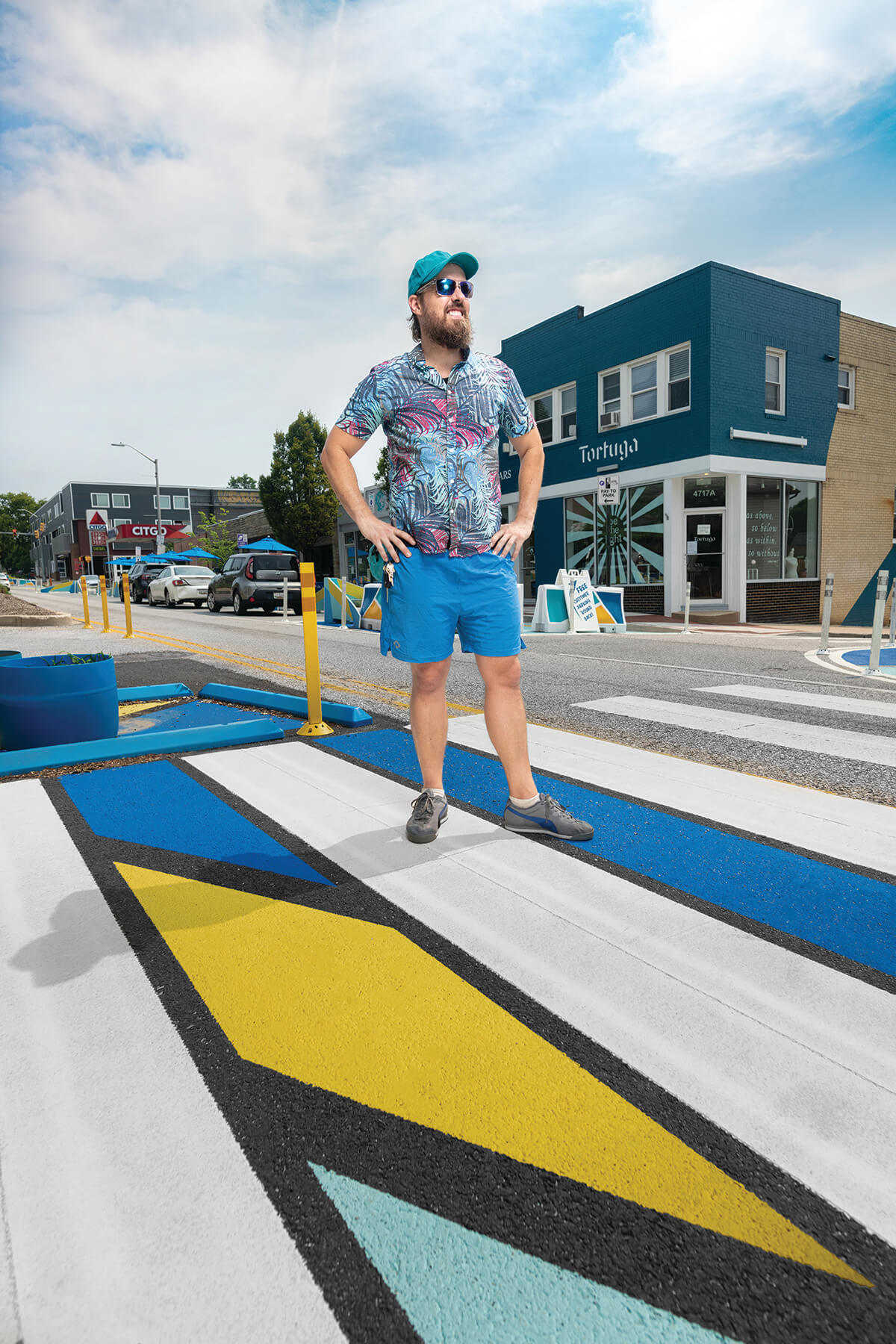Arts & Culture
How Graham Coreil-Allen Uses Public Art to Slow Down Cars
A collaboration with neighborhoods, transportation officials, and traffic engineers, the inventive art doubles as a traffic-calming tool.

In Reservoir Hill, a prismatic display has erupted over the asphalt and sidewalks. Last spring, Graham Coreil-Allen gathered neighbors to help paint the intersection at Whitelock Street and Brookfield Avenue with a carefully placed rainbow of literal street art, bolstered by flex posts and fresh crosswalk lines that, together, urge approaching drivers to slow their roll.
“Before it was a lot of speed-thru action going on,” says Lauren Miller, a local resident and volunteer at the Whitelock Community Farm across the street. Now, “it’s a cognitive thing. When you see brighter colors, you’re gonna look. You’re gonna stop.”
Since 2016, Coreil-Allen has run with that theory to make Baltimore City streets safer through his design-build business Graham Projects, working with neighborhoods, transportation officials, and traffic engineers on inventive art that doubles as a traffic-calming tool. The lifelong artist has built a brand on advocacy, engagement, and collaboration, becoming a sort of street-design expert along the way.
“My work is very much driven by the needs of communities,” he says. “No public art is ever going to make everyone happy, but the goal is to have an equitable process and something that builds bonds of spirit and, ultimately, trust.”
Interested in urban design since adolescence, Coreil-Allen immersed himself in making radical public art at the New College of Florida. After graduating, he moved to Brooklyn, New York, where he created work that called attention to issues such as pedestrian safety and affordable housing. He relocated to Baltimore in 2008 to earn his master’s degree at the Maryland Insitute College of Art, and his first permanent local street art project, “Hopscotch Crosswalks Colossus,” added four usable sets of painted footprints to an intersection in the Bromo Tower Arts & Entertainment District on downtown’s west side.
“When you see brighter colors you’re gonna look. You’re gonna stop.”
He’s since helped transform intersections across Baltimore. His portfolio only continues to grow, with the city—notoriously lacking in its pedestrian-friendly infrastructure—most recently announcing official partnerships with Graham Projects at busy intersections outside Druid Hill Park and Lake Montebello.
Coreil-Allen emphasizes that the spirit of his work is less about waging war on drivers than it is about humanism and empathy. He considers the roughly one-third of Baltimoreans who lack access to a car, per Census data: “Those people deserve the same level of safety and access as all the cars driving up and down the road.”
In an unexpected turn, his art also benefited from a burst of urbanist experimentation during the COVID-19 pandemic last spring through the city’s Design for Distancing program, which was created to help neighborhoods reorient public spaces for the pandemic era.
On Harford Road, Coreil-Allen worked with neighbors to reimagine three commercial blocks, filling a parking lane with benches and tables for seating, all set on a can’t-miss display of blues and yellows and protected by temporary barriers and planters. Using good old-fashioned community engagement, he crowdsources design details from residents, leads his own neighborhood association, and even co-chaired Mayor Brandon Scott’s Art and Culture Transition Committee.
How can he tell when his projects are successful? For one, there’s the before-and-after traffic behavior data gathered from his “walking audits” or collected by partners like MICA. And there’s the feedback from the actual users, like the bespectacled, elderly woman who approached him at Beaumont Avenue and York Road.
“Are you the designer?” she said, waiting for her bus near the painted, sunset-like medley of reds, yellows, and blues, featuring Adinkra symbols of birds and peace signs and more. Coreil-Allen smiled and shared his story. “I’m so glad you did this,” she said.